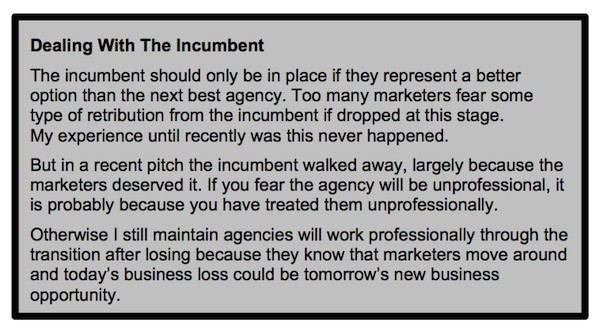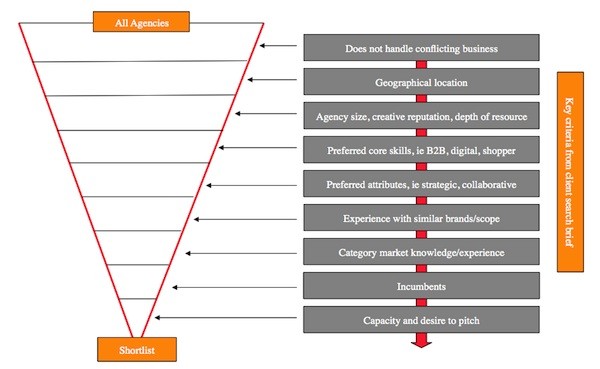Time and again I read about marketers and procurement wasting valuable time and money in their RFP and tender processes. They do this by taking as many agencies as they can handle through a long and cumbersome agency selection process.
Rather than wasting time and effort, we use a Filter or Stage and Gate process in managing potential agencies for our clients. The process is more efficient and effective. It also allows us to manage more and more complex selection processes where there could be multiple possible combinations of suppliers at the end of the process.
Deconstructing The Pitch Process
Basically a process of testing Capabilities, Chemistry, Skills, Cost and Contract in a particular order can define the typical pitch process. Some people make the mistake of taking every agency through the entire process. But if you provide a hierarchy of importance to this process, then it makes sense to use these criteria as a filter process. If an agency is not ideal or the best in the lower order criteria, why would you continue to assess them in the later stages hoping for a miracle.
This allows you more time to focus on those agencies that better fit your criteria. It eliminates the distractions of multiple agencies that may have a few desirable attributes and allows you to focus on the important core attributes in a designed and managed process.
There are a number of ways of structuring the process. Michael Lee at Madam in NYC famously launched with a process based on a “9-6-3-1” structure.
At TrinityP3 we recommend a similar guide (8-6-3-1) to look as widely as possible up front and then to filter to no more than eight for Credentials, no more than six for Chemistry and three for the final process (inclusive of the incumbent if they are still in the mix) and then one final successful agency.
Selecting the List of Possible Agencies
At TrinityP3, we have an online Agency Register database with confidential and detailed information about the agencies in the market we operate. This information is provided by the agencies and then checked and cross-referenced by our consultants. The TrinityP3 Agency Register provides us with the most comprehensive view of the marketplace. From this we filter a recommended list by a minimum of nine criteria being:
- Conflicts – Does not handle conflicting business
- Proximity – Geographical location
- Capability – Agency size, creative reputation, depth of resource
- Skills – Preferred core skills, ie B2B, digital, shopper
- Attributes – Preferred attributes, ie strategic, collaborative
- Expertise – Experience with similar brands/scope
- Experience – Category market knowledge/experience
- Fit – Incumbents
- Capacity – Capacity and desire to pitch
From this we prepare a list of suitable agencies to meet the marketer’s requirements. Plus a list of client conflicts, so that the marketer can identify and understand the competitive mix. The financial services market is one that is particularly competitive and diverse leading to a limitation on available great agencies based on conflict. And finally we provide a John West list. This is a list of agencies we have rejected that makes the list provided the best.
From this the marketing team and procurement can make an informed selection of no more than eight agencies, but ideally six to invite to provide credentials and meet for Chemistry meetings.
Lets look at these next filtering criteria, which we present in our recommended order, but are not locked in stone. After all, the requirements of every marketer are different and therefore the process needs to be customised to suit their needs.
Testing Capabilities in Credentials
It is not just enough to ask for the agencies’ capabilities, you need proof of these capabilities. One of the best ways to do this are with case studies. Some marketers and procurement people want to test capabilities at this stage by giving the agencies a test to complete to assess their abilities. The problem is that to create a test that is meaningful and relevant to the marketing team and their requirements means providing all of these agencies with details that are specific to the brand and strategy.
While the agencies are under a confidentiality agreement at this stage, you are exposing details to a wide range of agencies, most of whom will be ultimately unsuccessful. There is no guarantee that they will not use this information in some way. We did find out that one agency, who has been unsuccessful in a pitch with a client, was approaching their competitors on the basis that they had insights in the competitive category.
Testing Contract Compliance
There are many procurement people who like to provide the agencies with the contract up front to ensure there are no sticking points. The belief is that getting this out of the way up front will minimise issues at the back end. I agree to a certain extent, but it is not fool proof. It can also set a tone to the whole process that is about contract compliance and not capabilities, chemistry and skills.
We have also seen agencies agree with the contract at the start of the process only to create all sorts of problems with clauses later in the process. My recommendation is depending on the size and sophistication of the agency; provide them with details of the terms and conditions of the contract, especially around payment terms, term of the contract and IP arrangements, so they can make an assessment to participate up front.
Where possible have these discussions with the CEO, CFO or Commercial Director of the agency and not the creative or strategy leads, even if they have equity in the agency.
Chemistry is More than Having a Chat
I have written about Chemistry Sessions previously and the way that our approach differs from the usual. You can read about this here. The important outcome of the chemistry session is for the marketing team to meet, engage and challenge the agency team. The team represented here should definitely include the agency senior management and representatives of the various disciplines that will be working on the business.
Over the years we have had situations where the chemistry between the marketing team and a single member of the agency was an issue. It was a simple matter of having a confidential discussion with the CEO of the agency to discuss the issue. They were then able to access if they wanted to substitute that person with an alternative if available or not.
But ultimately is there is good chemistry between the two teams this is a reflection of shared culture, values and personality and an excellent bellwether of the immediate future of the relationship.
A Test of Suitable Skills
By this stage we recommend that the marketing team is down to no more than three agencies. One of these can be the incumbent. But it is definitely not three plus the incumbent. With this short list it is time to test their specific skills. The way this is tested depends on what criteria or ability you want to select the winning agency. If it is for channel media strategy, then the test should be for this. Or if it is strategic and conceptualisation then this is the basis of the test.
It is important that the test is appropriate to the desired outcome. Too often we have heard of marketers providing the agency with a very wide ranging brief. They have asked the agencies to go and work on this in isolation, Then on presentation of the idea have selected the one they like best. What is this test? The ability to mind read? Or how lucky the agency is? Or how many resources they can get in to solve the problem? Or perhaps they just wanted the idea to that brief? I am never really sure.

We have run workshops, presentations, strategy days, events and the like to make sure the process informs the decision making process and not obscure it.
Cost Is the Last Component in Value
While the process is not left to the end, the cost is always revealed at the end. We commence the financial proposal process at the short-listing stage of three. This process is designed to allow the agencies to provide a complete overview of their cost proposal and to allow us to provide a like-for-like comparison as well as accommodate a customised proposal from each agency.
The analysis of the financial proposal provides insights into:
- The suitability of the level and mix of agency resources
- The underlying pricing strategy of each of the agencies
- The ancillary costs for other services and the like
Only once the selection team has ranked their preferred agencies do we commence discussing the financial proposals. This is because value is based at this level on the perceived quality of each agency against the proposal cost. While I know of some pitches where the selection was driven on price, it is a short-term and wasteful strategy. If you want to select an agency on price, do not put them through a test of skills.
In most cases the discussion on the cost of the agency proposal is more about how then to deliver the value inherent in the preferred agency or agencies and their proposals. This is a discussion on the resources required, the mix of senior and junior and the most appropriate remuneration model to deliver this value.
Then There Is One
The final choice is the winning agency. The filter or stage and gate process allows you to systematically filter the agencies against your specific criteria. It reduces waste of time, money and resources for marketers and agencies. It provides focus and clarity in decision-making. It is efficient and effective in application. But it requires strategic focus and disciplined application.
Can anyone see why you would not want to use this process?






One thought on “A more efficient process for selecting the perfect agency”
Hi, Darren.
I just came across this article, along with many others that you have written with a focus on procurement. I am so appreciative to have your expertise and knowledge at my finger tips. While reading this article I couldn't help but think, how do agencies get registered within this database type of system? Are these agencies you have past dealings with? We are trying to expand our reach within procurement to be sure they are aware of who we are and what we do. How would you best suggest getting into systems?
Comments are closed.